FRIDAY
APRIL 15 - 2016
Eric's
news
Eric Eddles
saw and heard the sweet descending down-the-scale song
of a Willow Warbler at Baffins Pond on Tuesday
the 29th March and managed to get a quick shot of the
bird - on the left below. This is the earliest Willow
Warbler I have heard of locally. Eric also had 8
Wheatears on Saturday the 2nd April on the fields
of the sewage works at Eastney and got a shot a nice
photo of a female through the wire fence.
THURSDAY
APRIL 14 - 2016
Brook
Meadow
I had another
walk around the meadow this morning, mainly listening
out for migrants. I heard Chiffchaff and
Blackcap which have been here for a while, but
there was no sound of Whitethroat. It is still a bit
early for them.
Coming down the steps
from the north-east corner onto the meadow I spotted a
cluster of fungi growing at the base of the wooden
steps. Its caps were light brown in colour and cracked
white. There was one broken which enabled me to
confirm that the stem was thin and brittle and the
gills radiating out from the stem. From an internet
search my best guess is a species of Psathyella
- though I have no idea which one, or whether
this is right.
I had three
butterflies on this quite warm morning. Small
Tortoiseshell and Peacock rested long enough for
me to get a photo. They are over wintering species and
will have just emerged from hibernation. The other
butterfly was what I think was a Small White
which I followed for a few minutes as it flew around
the area without stopping.
At least two
Bee-flies were flying over the vegetation on
the Lumley area. They get their name from their furry
appearance. However, they are best identified from
their long straight proboscis and hovering flight.
They are usually seen hovering in front of flowers
sucking nectar through their proboscis, but not today!
They are usually recorded on Brook Meadow at this time
of the year. Ralph Hollins also had his first Bee-fly
yesterday in his garden, so keep a look out for them
in yours.
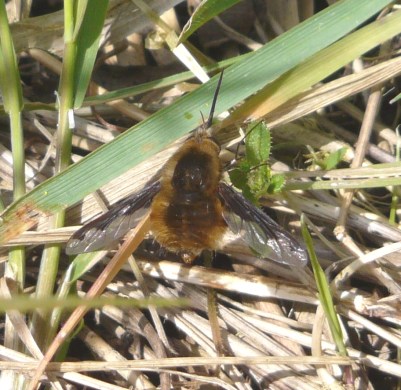
The first Common
Spotted Orchid leaves were showing on the
grassland just north of the twig barrier around the
official orchid area. I marked them with a stick. They
usually come up in this area. I did not see any other
orchid leaves.
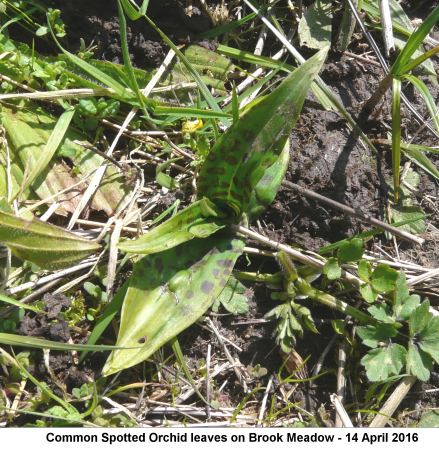
Meadow Foxtail
continues to dominate the north meadow, but I did
notice a few spikes of Tall Fescue for the
first time this year. It will soon be all over the
meadow - the dominant grass of Brook Meadow.
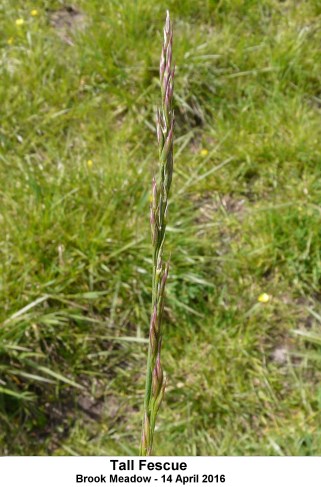
Ralph's
problem
Yesterday, my good friend and mentor, Ralph Hollins,
left his computer to have his tea only to find, when
he returned, that his computer had been hi-jacked by
Microsoft to install Windows 10. This made it
difficult for Ralph to find some of the files that he
relies on for creating the web pages that make up his
daily blog. He concluded . . . "If you ever see what I
have just written (in the blog) you will know that
Microsoft has not beaten me yet but I fear that I am
about to be extinguished!"
I am publishing this just in case anyone out there can
offer any advice to Ralph in his hour of distress. I
believe he had Windows 7 until Microsoft messed it up.
I have heard from reports in computer magazines that
this policy of Microsoft installing Windows 10 is
causing a good deal of anguish. I am relieved I never
updated my splendid Windows XP which still works
perfectly despite dire warnings issued by you know
who!
WEDNESDAY
APRIL 13 - 2016
Portsmouth
I have a mooch
around some of my old haunts in Southsea and Eastney.
It was a warm morning and I was hoping to find some
early bird migrants and also some butterflies, but I
drew a blank on both of these. However, I noted
several other things of wildlife interest.
I counted 44 Mute
Swans on Canoe Lake, Southsea. This will be the
same flock that I counted 43 of in February. Clearly,
Canoe Lake has its resident swan flock back after
about 10 years absence. Numbers will fall during the
summer to recover in the autumn and winter.
On Eastney Beach there
were lots of leaves and of what appeared to be Wild
Radish around the beach area. I found just one
plant in flower with bright yellow petals. I am never
sure if these plants are Wild Radish or Sea Radish.
Both, I gather can have either white or yellow
flowers. They are easier to distinguish later in the
year from their pods.
I had a walk around
the Fort Cumberland Open Space (SINC) which is the
area of land slightly to the west of the fort itself
at Grid Ref: SZ 679992. This site was a regular haunt
of mine some years ago, but I don't get there too
often these days. This open space is the largest area
of natural coastal heathland in Portsmouth, which has
developed on a large stable shingle bank. It has a
fascinating variety of wild flowers in summer, such as
Fennel, but there was not a great deal to see today
except for Bulbous Buttercups and Sweet
Vernal Grass which were both widespread over the
site. I was reluctant to pull up any of the Buttercups
to check for bulbous roots to rule out Hairy
Buttercups.
Langstone
Mill Pond
Peter
Milinets-Raby walked in via Wade Lane to the Langstone
Mill Pond this morning (10am to 11:35am - low
tide.
"Lovely blue sky and warm sunshine - too idyllic! But,
as usual it has been a slow spring in our part of the
World. Typically everywhere else is getting Wheatears,
Whitethroat, Redstart, Sand Martin etc. It would even
help if some Willow Warblers held territory in the
area, BUT, they only pass through and I have not seen
or heard one yet. Every spring has been the same so
far, just the odd migrant!
Wade Lane: Female Kestrel showing well for a
change (see photo), 2 male Pheasant, 2 Linnet, 1
Mistle Thrush, 3 Pied Wagtail, Green Woodpecker heard,
Chiffchaff singing and 2 Swallows flying over the
horse stables checking on their old nests. A Stoat
dashed across the road (nice surprise).
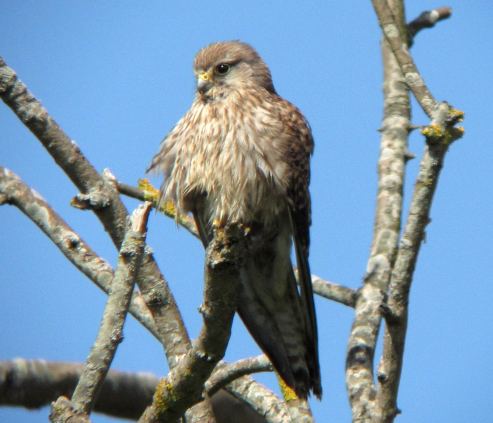
Flooded paddock: 7
Moorhen, a Green Woodpecker feeding on the grass,
Chiffchaff heard and Blackcap Heard.
Langstone Mill Pond: Despite the warm still weather,
no Reed Warblers yet - must be in tomorrow!! Reed
Bunting singing, Chiffchaff singing. 7 Little Egrets
actively nesting/displaying/standing guard at old
nests and all with cute burnt-blood red feet!
Grey Heron Heronry: Nest 6: a single young seen and
photographed.
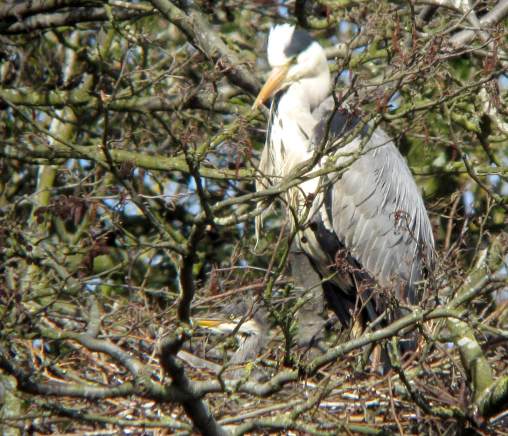
Off shore: 31
Black-tailed Godwits, 1 Greenshank and surprisingly
only 2 Med Gulls!!!
First
Cuckoo
A Cuckoo was
heard near Matley in the New Forest today. Has anyone
heard one locally? They should be coming in at any
time now. According to the British Trust for
Ornithology the first tagged Cuckoo is now back in
Europe having successfully crossed the Sahara Desert.
Go to . . . http://www.bto.org/science/migration/tracking-studies/cuckoo-tracking
TUESDAY
APRIL 12 - 2016
Emsworth
- Thorney
It was a fine
spring morning, just right for a cycle ride down to
Thorney Island to check for early migrants. I stopped
at various sites along the way:
Railway
Wayside
I had a quick look at the Railway Wayside north of the
station, where the Coltsfoot is still looking
very good, but I could see nothing else of interest
from the ramp. The site was much too muddy to go onto.
Brook
Meadow
Going through Brook Meadow I noticed
Three-cornered Garlic in flower immediately
outside the Seagull Lane gate.
I heard both Chiffchaff and Blackcap
singing from along the north path - as I did
yesterday. These birds will be setting up breeding
territories. No sound of Whitethroat, but it is a bit
early for them.
The two newly planted Silver Birch trees that
were donated to Brook Meadow by a local resident are
now both in leaf and look in good health.
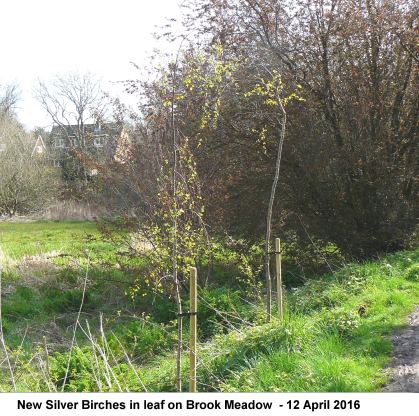
Brian Lawrence was
also on Brook Meadow today and saw several butterflies
including Small White, Comma, Brimstone Speckled Wood
and Peacock. Brian also saw a Blackcap -
probably the same one that I saw singing.
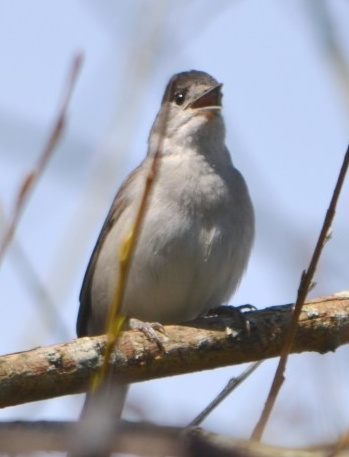
Slipper
Millpond
When I passed by Slipper Millpond the Mute
Swan was snug on her nest in the reedbeds on the
east side of the pond.
At first there were no Great Black-backed Gulls
on the centre raft, but they both turned up while I
was there and proceeded to display and to mate. When I
left one gull was sitting on the nest, presumably
laying eggs as mating is still happening.
I can confirm that
Coots are nesting on both the north raft and
the south raft. There may well be another nest on the
pond somewhere that I have not seen. I was interested
to watch the Coots bring small pieces of twig to
reinforce the barricade in the boxes.
Emsworth
Marina
I was
delighted to find a nice new seat on the seawall at
the marina along with raised flower beds and a newly
grass seeded area. This made a nice break for coffee
and to listen to constant cries of the Mediterranean
Gulls overhead.
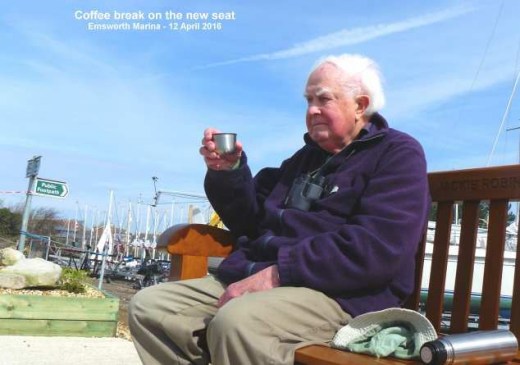
There was nothing of
interest along the dead end path apart from the bright
fresh leaves of Hemlock with red spotted stems.
There is no Mute Swan nest on the marina embankment.
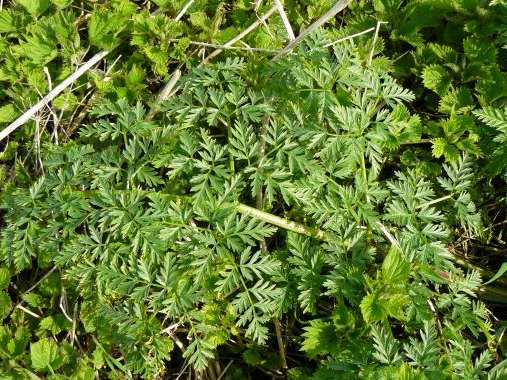
Thorney
Island
I walked
slowly along the old NRA track listening out for any
migrant warblers. I only heard Chiffchaff and
Blackcap plus a couple of very loud Cetti's
Warblers. No Whitethroat or Sedge Warbler. I saw
two Peacock butterflies, but neither stopped
long enough for a photo. There was a pair of Grey
Herons flying around the trees south of the NRA
track which are probably nesting somewhere.
I walked down the western track as far as Little Deeps
listening in the usual spots for Sedge Warbler, but I
did not hear anything but more Cetti's Warblers. There
were three Black-tailed Godwits in the harbour
and a few Redshank.
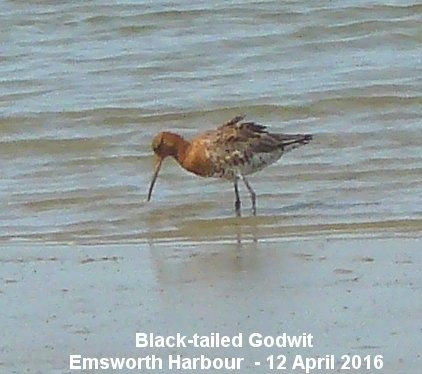
Three Tufted Duck were
on the Deckhouses Estate pond, but no sign of any
nesting Mute Swans this year.
Bridge
Road Wayside
Finally, on my
way home, I found my first Barren Brome grass
of the year on the northern grass verge of the Bridge
Road Wayside near the signcase, about a week earlier
than normally.

Mystery
insect
Tony Davis has
identified the mystery insect photographed by Chris
Oakley in his garden as the sawfly Zaraea
lonicerae. Many thanks, as always, Tony for
your help. It is not in my copy of Chinery's Collins
Guide to Insects, and that basically is the extent of
my knowledge of insects.
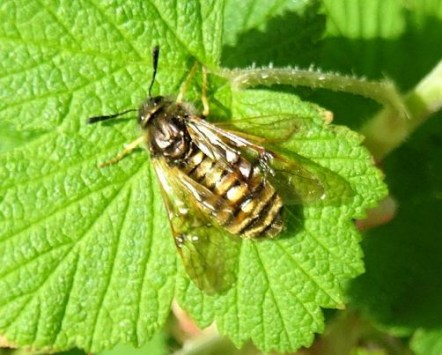
Horndean
Down
Peter
Milinets-Raby found myself in Horndean with an hour to
spare, so went for a walk along the top of the
Horndean Down (from 1:30pm): Some good birds seen:
male Bullfinch, singing Blackcap, Mistle Thrush, 3
Pheasant, 2 to 6+ singing Skylark, 11 Buzzard in the
air together on one thermal. Two Swallow flying
through, 7+ Linnets, a single Yellowhammer and 3
male Wheatear (right at the top).
Finished off with some great views of a Raven
attacking/chasing a Buzzard, then 10 minutes later
attacking a Carrion Crow with a peregrine-like dive
from 200 metres up!!! A nest is visible on the usual
pylon, but could not see into it. By the way the Raven
was aggressively patrolling the area, it is probably
occupied.
MONDAY
APRIL 11 - 2016
Brook
Meadow
I had a stroll
around Brook Meadow this afternoon after the rain. It
was very wet underfoot with the meadow covered in a
layer of water, but I managed without geting too
wet.
I was particularly pleased to hear both
Chiffchaff and Blackcap singing strongly
in several places, so these two migrants have
certainly arrived. I tried to get a shot of the
Blackcap singing from a tree in the western
plantation, but lacked Malcolm's skill and equipment.
Here is my best shot.
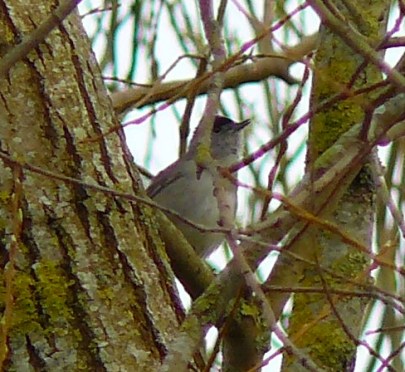
The only other bird of
interest was a Moorhen prospecting for nesting
sites on the river beneath the now rapidly diminishing
gasholder. A 7-spot Ladybird was resting on a
nettle leaf nearby. I have not seen any other species
of Ladybird.
Meadow Foxtail
is now well out on the north meadow, but I did not see
any other grass flowers. However, I did find my first
Divided Sedge and Distant Sedge of the
year, both in the usual place on the east side of the
wet Lumley area. They are quite easy to distinguish as
Divided Sedge has a cluster of male and female
spikelets at the top of a stem whereas Distant Sedge
has a long male spikelet above 2 or 3 female
spikelets. Distant Sedge also grows in tufts whereas
Divided Sedge is generally scattered around.
I was also pleased to
see Lesser Pond Sedge looking very good with
anthers showing prominently on the river bank below
the S-bend.

I had a look around
the flower rich area in the centre of the north meadow
and found leaves of Bee Orchid, Great
Burnet and Meadowsweet - so we have their
flowers to look forward to later in the year. The
fertile cones of Field Horsetail were very
prominent on the main orchid area.
House
Martin survey
Caroline
French provides an update on the House Martin survey
she is conducting in Westbourne - the only place
locally where these birds nest. She needs help, so if
you can help please let me know and I will pass it
on.
Caroline says, "I distributed over thirty letters and
leaflets and had a response from five households, who
said they were happy for me to monitor nests on their
properties. One property looks like the birds began to
build a nest but then abandoned it before they have
got very far - I probably won't monitor that one. On
another house, the birds nest at the rear of the
property so I can't easily observe it. However, there
is an additional property which is empty, which has
nests on it, so I will try to monitor those too. So,
in all, I currently have four properties to monitor,
with 12 nests in total (from last year or previous
years). I'll have to see how things go - how much time
it takes etc. I may not be able to do them all, but
I'll try. I'll let you know how it goes. "
Hedgehog
news
Caroline
French also reports that "about 10 days ago I spotted
droppings in the garden and about 6 days ago a
hedgehog moved into one of my boxes, the same one
which was used by the female which produced two
litters last year."
Langstone
Mill Pond
Peter
Milinets-Raby had a brief visit to Langstone Mill Pond
this afternoon (1:43pm to 3:20pm just as the drizzle
finished - high tide and flat as a pancake!)
The highlights were: the first Sandwich Tern, 1
Swallow, 42 Med Gulls loafing on the water off
Pook Lane (See photo - different from those seen
later), 10 Brent Geese, And a distant Great Crested
Grebe off Conigar Point.

On the pond the Mute
Swan stood up and I counted 7 eggs. Chiffchaff heard
singing.
12 Little Egrets milling about - lots of
display and territorial fighting/squabbling over old
nests - a couple of birds hanging about next to a
nest. Give it to the weekend and the place will be
heaving with egrets.
Heronry very busy: Top Holm Oak adults sitting
again for second. Lower Holm Oak adult sitting for
second brood. Old South Nest young departed: Other
Holm Oak 3 juvs on the verge of fledging: Nest 5 adult
sitting. Nest 6 very young chicks, two for sure - both
adults in attendance. Nest 7 two middle aged young:
Nest 8 adult sitting. Nest 9 adult sitting:
Quickly visited the Northney Horse paddocks as I
noticed more Med Gulls milling about. When I arrived I
counted 141 of them feeding on the grass with a lone
Brent Goose (at least 3 were in winter
plumage).
SUNDAY
APRIL 10 - 2016
Nest
of snails
As we are
having our old garden shed renovated, I removed what
had become a badly rotted House Sparrow nest box with
three sections. The box has been attached to the shed
wall for the past 19 years and has been occasionally
used by Blue Tits, but never by House Sparrows. When I
opened up the lid I was surprised to find the central
section lined with at least 20 Garden Snails. These
presumably will have been hibernating over the winter
period and will soon be waking up. I shall need to
relocate them to save our tender garden plants from
their ravenous jaws! Any offers?

Mystery
insect
Chris Oakley
has a good selection of bees and hoverflies already
visiting his garden, but one has puzzled him. He says,
"It is not an ordinary wasp as it has eight tegrum
(yellow bands) rather than the six found on a common
wasp. The antennae are clubbed and black, the legs are
entirely yellow and the wings are a pronounced brown
colour. There is also a yellow band behind the eyes.
It is quite small being about fifteen centimetres. I
feel it's likely to be a hoverfly of some sort or
perhaps a sawfly. Can any of your readers help me to
identify it?"
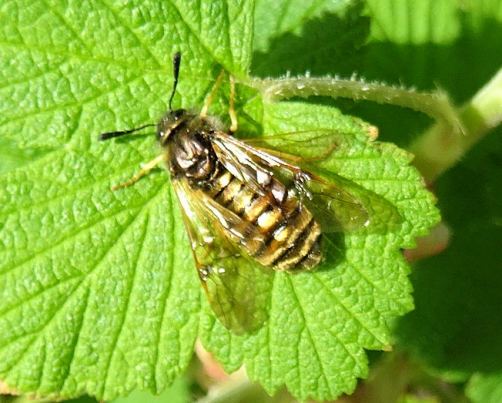
That's a tricky one
Chris. My money is one some sort of wasp, but I have
little knowledge of these creatures apart from the
common ones.
Emsworth
to Langstone
Peter
Milinets-Raby was out again early this morning for his
regular bird walk and survey from Emsworth to
Langstone.
He says, "If it was not for the many Mediterranean
Gulls seen this morning, it would have been a very
dull morning. Bright blue skies from sunrise, so not
ideal, even though the wind will entice stuff in over
the next few days.
Started at Emsworth Harbour at 6:37am (very low tide):
A single Greenshank hanging around (RG//- + BYtag//-),
2 Little Egrets, 3 Med Gulls flying over calling as
they headed inland. 3 noisy Canada Geese and 2
Shelduck.
Beacon Square: Lots of low tide mud and 4 +4+2+3 Med
gulls flying over heading north.
Nore Barn from 7:14am: Another single Greenshank and
yes you've guessed 2 more Med Gulls passing over. Grey
Heron heading west, obviously heading towards
Langstone Mill Pond.
Ibis Field from 7:28am: 2 Moorhen, 3 Stock Doves and 4
Med Gulls calling as they headed in land - very close
overhead, so some superb views!!
Conigar Point: 2+6+2 Med Gulls over. Cetti's Warbler
heard singing from the mini reed bed.Singing
Chiffchaff in Tamarisk Hedge.
Off Pook Lane: 7 Shelduck, 3 Little Egrets feeding
amongst the four bait diggers in the tiny trickle of
water in the channel. Plus another single Greenshank.
And 2 Mediterranean Gulls . . . . . with more
calling,
Very quiet with wader numbers way down - in total at
all sites I only saw about 25+ Redshank, 20+
Oystercatchers and 15 Curlew. Gave up at
8:20am."
Brian's note on
Mediterranean Gulls
Without exception, everyone agrees that there are
masses of Mediterranean Gulls around this year.
Personally, I can't go out of my house in Bridge Road
Emsworth without hearing their plaintive calls
overhead and they have been common on millponds and
fields everywhere. What accounts for this sudden surge
in numbers? Here are a pair of Mediterranean Gulls
that I got on Slipper Millpond on March 28th. Note
their jet back heads and bright red bills and lack of
any black on their winds.
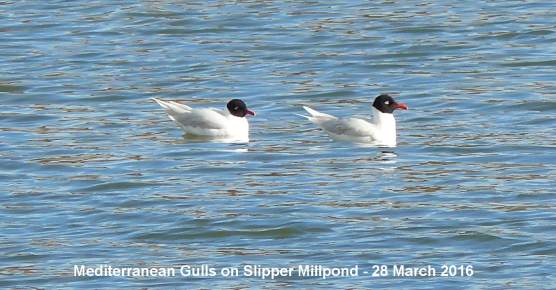
SATURDAY
APRIL 9 - 2016
Mystery
plants - Spring Starflower
My thanks to
Ralph Hollins for identifying the mystery plants that
I found growing on the roadside verge in Park Crescent
yesterday. They are called Spring Starflower -
(Tristagma uniflorum or
Ipheion uniflorum) - and are currently
spreading across England.
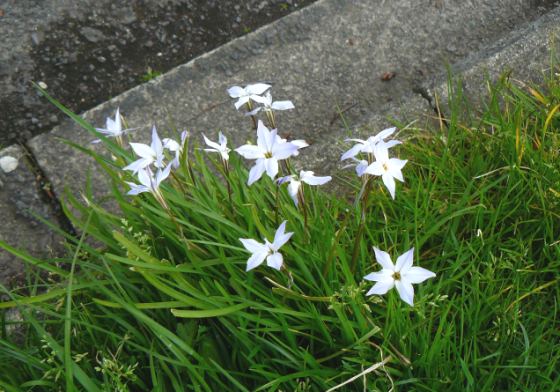
Ralph has seen them
for some years at one wild site on South Hayling where
they have been mown recently.
See http://www.ispotnature.org/node/783046?nav=latest
. . . for a good photo and click the link to the NBN
Gateway for a map of their current distribution in
Britain where they are found mainly in South of
England and East Anglia with a cluster in the London
area. It seems they were first brought to Britain in
1820 but have only recently started spreading
rapidly.
Toothwort
search
Peter
Milinets-Raby and his young son Aleksandr walked
around Mill Copse (NW of Horndean - 10am to 11:15am).
They were hoping to find the unusual parasitic plant
called Toothwort (Lathraea squamaria)
which Peter had been told could be found there. My son
also named Peter reported seeing hundreds of Toothwort
plants in Eaglehead Copse on the Isle of Wight, but
they appear to be relatively scarce here on the
mainland (except in North Hampshire). Here is Peter's
photo of one - see blog for April 4.
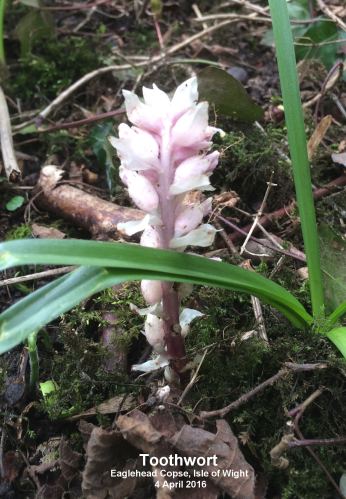
Peter Milinets-Raby
and his son did not find any Toothwort in Mill Copse,
but they did enjoy a lovely display of Bluebells. The
whole wood floor was covered in them!

Other wildlife
reported by Peter included 2 Roe Deer (a pair),
Buzzard, 3+ Pheasant, Yellowhammer, Skylark singing,
Chiffchaff singing, Great Spotted Woodpecker drumming
and calling, 2 Long-tailed Tits, 2+ Chaffinch and
singing Goldcrest.
They also quickly called in at Lowton's Copse which
was another possible Toothwort site mentioned by Ralph
Hollins, but again nothing was seen. "Never mind,
pleasant walk, no pain, no gain."
FRIDAY
APRIL 8 - 2016
Wayside
flowers
Prompted by a
glowing report from Ralph Hollins yesterday of the
wayside flowers that he had seen along the Havant
Road, I decided to cycle up Victoria Road and Selangor
Avenue this morning to have a look at them for myself.
But, imagine my dismay when I met several
yellow-jacketed Council workers with huge grass
cutting machines gradually making their way down the
road towards me. Hell, they had beaten me to it.
However, I pressed on in the hope that some flowers
had been spared or somehow escaped the mower's
blades.
Turning right at the end of Selangor Avenue I made my
way slowly down the north side of the Havant Road
where a new tarmac cycleway now covers what used to be
a nice grass verge by the road. The remaining verge
next to the hedgerow had been strimmed, but some of
flowers mentioned by Ralph had survived. This verge is
certainly worth preserving and I will ask Jayne Lake
of HBC about making it a protected wayside, to be cut
just once a year in late autumn. Grid Ref: SU 733060.
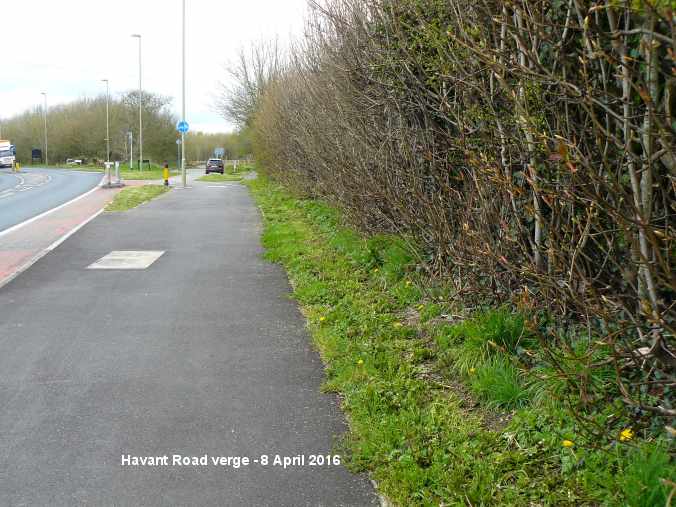
Flowers noted included
Dove's-foot Cranesbill, Spotted Medick, Cow Parsley,
Red Dead-nettle and Common Field Speedwell among many
others yet to come.
Dove's-foot
Cranesbill on Havant Road
verge
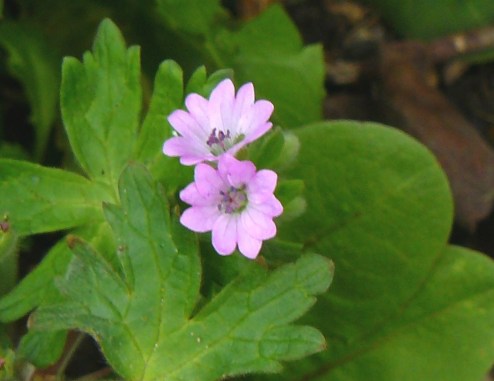
However, the best find
of the morning in the Havant Road hedgerow just west
of Selangor Avenue was my first Hawthorn
blossom of the year. May blossom on April 8th!
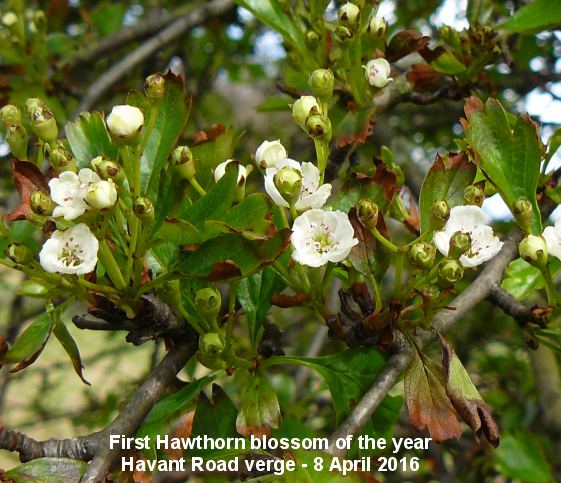
I carried on to have a
look at the verges by the Warblington underpass which
had also been cut earlier this morning. The best
flowers were right next to the kerb stones on the way
to the underpass, including Red Clover and the first
tiny white flowers of Hedge Bedstraw.
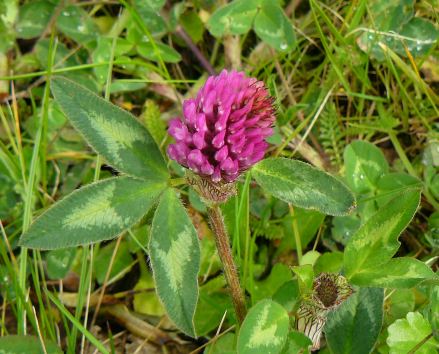
I was pleased to show
these and others flowers to three of our Brook Meadow
volunteers who were coming back from shopping in
Havant. I had one amusing encounter with a chap who
saw me peering down at the ground and asked if I had
lost something. When I told him I was looking for wild
flowers his response was 'Don't bother. They are just
weeds'. I let things rest at that. This was about the
time when I spotted a 7-spot Ladybird crawling
around in the grass.

I was relieved to see
that the wide verge by the main road which houses the
Bee Orchids had not been cut, thanks to prompt action
by Jayne Lake of HBC following our visit to the site
on March 24th. The Bee Orchid leaves are still fresh
and prominent, but no sign of any flowers as yet.
Jayne suggests we put up conservation area signs to
indicate clearly which area should not be cut until
late autumn. Grid Ref: SU 730059.
I was interested to find a small clump of what I think
may be Common Cornsalad in flower near to the
orchid area. Although Keel-fruited Cornsalad is the
default Cornsalad in our area, I gather this flowers
much later than Common Cornsalad (late June-August)
which is an early flowering species (April-June).
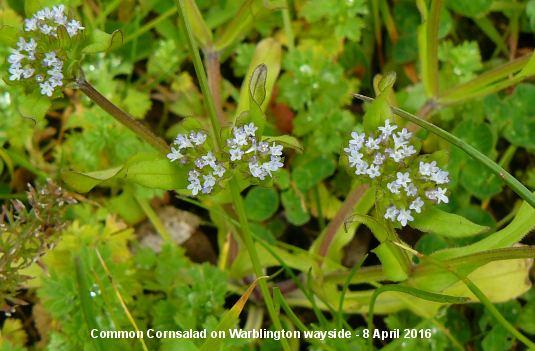
On my home I noticed
several bunches of white star-like flowers with purple
tinged petals on the edge of the grass verge on the
northern side of Park Crescent. From a distance they
looked a bit like Three-cornered Garlic, but the stems
were round with a single flower at the top of each
stem. I assume they are a garden escape or maybe
planted. Grid Ref: SU 740061.

Rookery
I counted 24
nests in the Rookery behind the flats at the western
end of Victoria Road immediately opposite the entrance
to Emsworth Primary School. This slightly up on the
last two years when I counted 22 nests. This is the
only Rookery in Emsworth - apart from the close with
this name off Lumley Road that is.
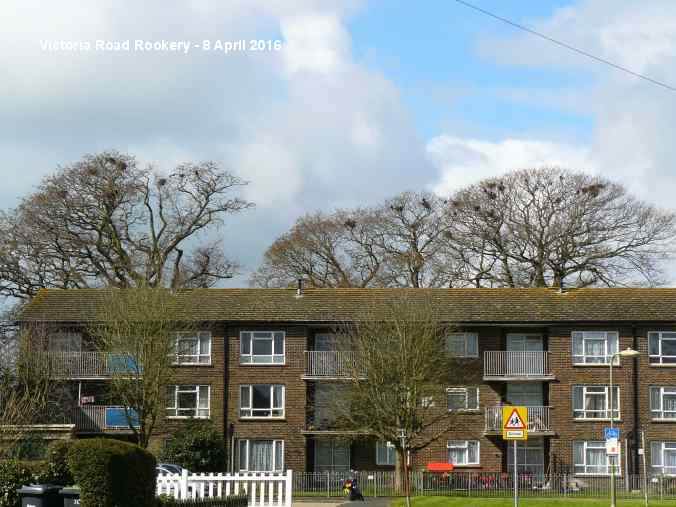
Avocet
breeding at Medmerry
Regarding the
sighting of 40 Avocets at Medmerry RSPB reserve
yesterday by Christopher Evans and others, Ralph
Hollins pointed out that Avocets have been breeding at
both Medmerry and Rye Harbour for a year or more and
he suspects that those that Christopher saw intend to
stay there which is good news indeed!
Langstone
Mill Pond
Peter
Milinets-Raby put in an hour at Langstone Mill Pond
from 2:50pm - high tide).
Not much in the way of birds: Grey Heron Heronry: Nest
7 had three calling chicks just visible above the nest
line. 11 Little Egrets initially just roosting, though
after 10 minutes five of them started prospecting the
Holm Oak and clearly staking out previous nests. Lots
of display and territory claiming. Another three
plonked themselves on the island in the middle, taking
up residence on old nests. The other three kept on
roosting! Spring has sprung! Chiffchaff singing at the
rear of the pond. Three pairs of Tufted Duck on the
pond (a typical date - also getting ready to nest
somewhere on the pond.)
Horse paddock: Getting empty, with 4 Teal, 6 Moorhen,
2 Little Egrets, a singing Chiffchaff.
Best sighting was of TWO Common Seal together
swimming trough the channel heading east. Also 2 Great
Crested Grebes and 14 Med Gulls and 2 Great
Black-backed Gulls.
Ducklings
at Baffins Pond
Eric Eddles
had a delightful sighting at his local pond this
morning with this family of nine ducklings, all pale
like their mother, but for one 'black sheep' of the
family.
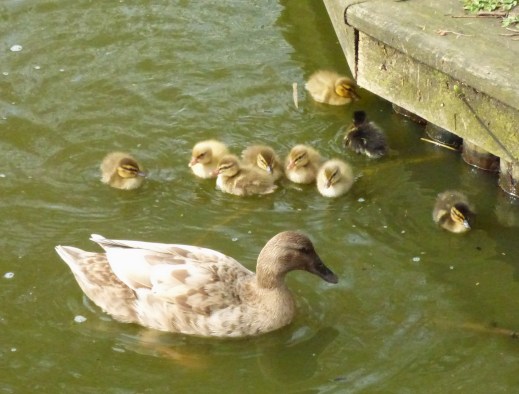
THURSDAY
APRIL 7 - 2016
Slipper
Millpond
The Great
Black-backed Gulls are nesting again on Slipper
Millpond for the 5th year running. What I assume was
the female bird was sitting on a nest of twigs on the
end of the centre raft with its mate on the water
nearby.
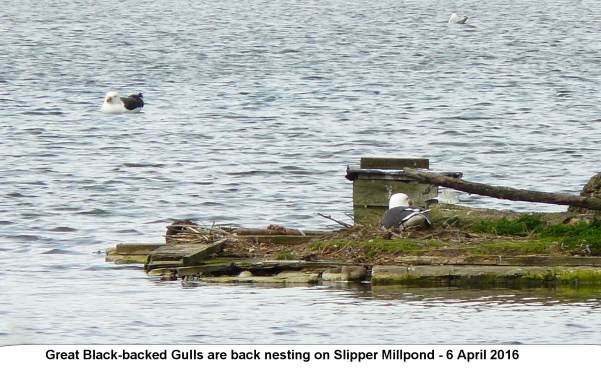
I last checked on Apr
3 when neither of the gulls was on the pond, so the
nesting and laying must have occurred in the
intervening period. Incubation takes 27-28 days, so
hatching is predicted for May 2-5. This is about the
same date as the expected hatching of the Mute Swan
eggs, so that could be interesting! This morning, the
Mute Swan was snug on her nest in the reeds on the
east side of the pond. Coots are also nesting on the
north raft.
Meanwhile, over on Peter Pond a Coot has a nest in the
reedbeds on the east side of the pond, viewable from
the A259 roadside.
Dog-violets
on Lillywhite's path
Ralph Hollins
commented on the photo of the Dog-violets in
yesterday's blog, which I tentatively identified as
Common Dog-violets. Ralph said, "A lot of variation
and hybridisation seems to occur with Violets, but I
would record those in your photo as Early/Wood Dog
Violets (V.reichenbachiana) despite the
notch (which only seems to occur on the left hand
plant) To me the critical feature is that the spurs
and long, thin, straight and dark violet in colour.
Common Dog Violets usually have shorter, broader and
paler spurs".
I had another look at the flowers this afternoon and
have to agree with Ralph. See the following photo. The
spur is certainly straight and is darker than the
petals. However, it does have a very clear notch at
the end of the spur which I had previously considered
the defining feature of Common Dog-violet, but clearly
it is not! Also, the upper petals of the flower look
remarkably like rabbit ears, which is a feature of
Early Dog-violet highlighted by Frances Rose (New Ed
p.186) .
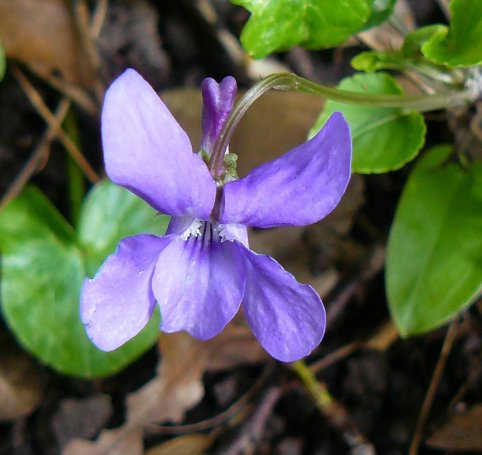
Will
Water Voles ever return?
I have been
corresponding with Ses Wright who is a Project Officer
with the Ouse & Adur Rivers Trust (OART) and the
Arun & Rother Rivers Trust (ARRT) about the state
of the River Ems on Brook Meadow. You may recall that
Ses and her colleagues visited Brook Meadow on Oct 15
last year to construct two shallow brushwood shelves
creating a small meander in the river to help fish and
small mammals, like Water Voles. I asked Ses what
chance we had of geting our Water Voles back on the
River Ems. Here is a shot of what could be our last
ever Water Vole on Brook Meadow taken by Malcolm
Phillips on 23 April 2015.

She replied, "That's
not easy to predict with confidence, however, if you
improve habitat diversity within the river (as per the
artificial berms and log flow deflectors) this will in
turn help to scour and clean the flow and deepen the
riverbed which in turn enables other plants and
invertebrates to populate the river channel which all
helps to build resilience into the river - which are
all things that water voles like and rely upon.
Managing dogs, brown rats and monitoring for possible
mink risk are all good precautions too."
RSPB
Medmerry
Christopher
Evans was with the Havant U3A Birdwatching Group at
RSPB Medmerry this morning, where they saw some 40
Avocet on the pool nearest to the sea wall. Here is a
photo of a couple of them. I suspect they will be on
their way to their breeding grounds shortly, maybe in
East Anglia or on the Continent.

Other highlights were
Little Ringed Plovers and a pair of Yellowhammers. On
the way back, Christopher called in at Chichester
Marina, where the Black Swan was sitting on the nest
on the canal. This is clearly a new nesting site for
this striking bird.
WEDNESDAY
APRIL 6 - 2016
Greater
Celandine
On his way
back from Thorney Island on Apr 2, Ralph Hollins came
back through Emsworth where he happened to notice a
tiny front garden at the junction of Queen and King
Streets which was full of Greater Celandine flowers -
the first he had seen this year. I was excited by this
news as it was a new site in Emsworth for this scarce
plant; the only other place I know where it regularly
comes up is near the small bridge at Lumley Mill at
the end of the footpath from Seagull Lane.
So, in drizzly rain this morning, I went to have a
look at this garden for myself which I had never
previously noticed. The garden is small at the front
of a house that appears unlived in; the garden is
unkempt and full of 'weeds', but is enlivened by the
presence of a mass of Greater Celandine, some with
delicate yellow flowers.
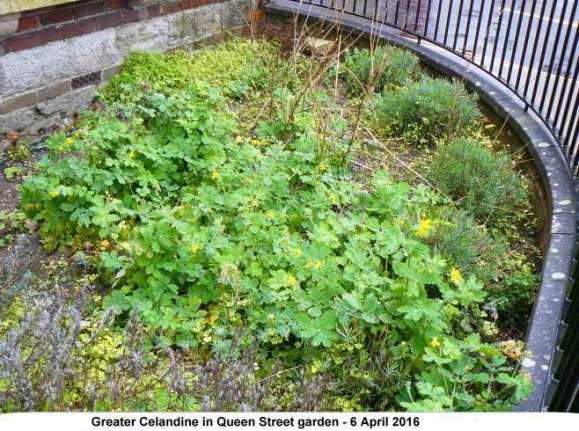
Despite its name
Greater Celandine has no connexion with Lesser
Celandine apart from the colour of its flowers. In
fact, it is a member of the Poppy family and was
introduced into Britain in Roman times and was once
cultivated as a medicinal plant. Rose describes it as
'poisonous' so maybe it is best avoided! It is now
well established mainly in the south and can usually
be seen growing at the base of walls in towns. It
usually flowers from May to August, so these flowers
are early.
Lillywhite's
path
I had some
interesting observations while walking along the path
behind Lillywhite's Garage this afternoon on the way
to collect my car which was having a wing mirror
replaced - vandalised last weekend! First I noticed a
few dark blue violets on the north side of the path,
almost opposite the larger growth of Sweet Violets on
the south side. I have seen these violets in previous
years and have always put them down as Common
Dog-violets mainly on the basis of their notched
spurs. But I always have problems with violets. Could
they be another species? Do any other violets have
notched spurs?
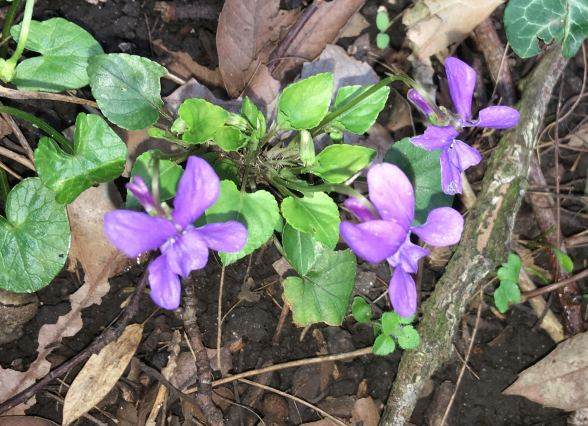
Also along the path I
noticed my first unsheathed Lords and Ladies of
the year showing its spadix - rather weather beaten.
Finally, I looked carefully for any signs of the
Hawthorn coming out; the buds were there and
looked about to burst, so it cannot be long before we
see the May blossom.
TUESDAY
APRIL 5 - 2016
Eastney
Beach
Jean and I had
a walk along the prom at Eastney this morning, keeping
an eye out for any early flowers on the beach. Very
prominent were the bright orange flowers of Pot
Marigold. These are garden escapes, but are now
well established on this beach and may well have over
wintered during this very mild winter.
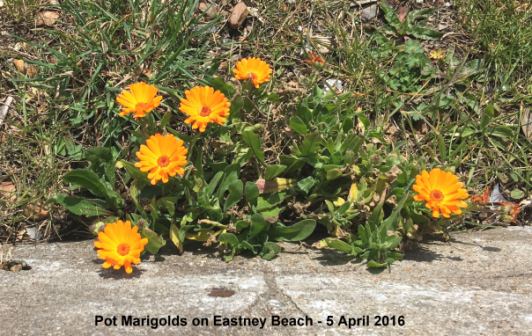
Silver
Ragwort (Senecio cineraria) is
another plant which is now well established on Eastney
Beach with its distinctive silvery leaves and yellow
flowers just starting to show on some plants. Red
Valerian is also fully naturalised on the shingle
beach and its red flowers are just starting to open.
When fully open Red
Valerian provides a fine spectacle on the beach
contrasting with the white flowers of Sea Kale. Here
is a photo taken in early summer a few years ago.
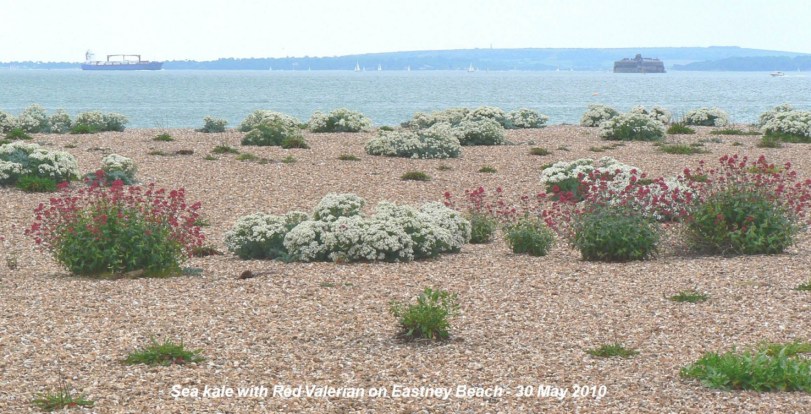
We also noticed
several clumps of Common Whitlowgrass on the
edge of the prom walkway.

Toothwort
Ralph Hollins
was particularly pleased to see the photo of this
unusual plant in yesterday's blog as it revived
distant memories of when he came across Toothwort in
Lowton's Copse just north of Clanfield in 1987.
Ralph's sighting was recorded as a first for the
square SU7018 in The Hants Flora (p.219). I wonder if
can still be seen there?
MONDAY
APRIL 4 - 2016
Toothwort
My son, Peter
sent me this photo of Toothwort which he took
yesterday during a family walk through Eaglehead Copse
on the Isle of Wight. Personally, I have never seen
this plant and I look forward to going over to the
island in the next few weeks while the plants are
still present. The Hants Flora shows no records in our
area at all; most are in North Hampshirre.

The article in the
current issue of the magazine 'Wildlife' from the
Hampshire Wildlife and Isle of Wight Trust highlights
Eaglehead Copse as the best place on the Isle of Wight
to see this unusual plant. The Isle of Wight Flora
(Pope, Snow and Allen) describes Toothwort as "locally
frequent in woods on chalk or heavy clay soils" and
says that Eaglehead Copse can hold over 2,000 plants,
in three different colour forms, white (the most
common), lemon-yellow and beetroot red.
Toothwort is a member of the Broomrape family which
are parasites on various plants and have leaves
reduced to scales with no chlorophyll and are hence
not green. Toothwort has tubular flowers in one-sided
spikes up to about 25 cm which die down quickly after
flowering. It gets it name from the flowering spikes
which resemble rows of teeth. It is parasitic on
mostly Hazel and Elm.
Langstone
Mill Pond
Peter
Milinets-Raby paid a quick visit to Langstone Mill
Pond this afternoon (2:40pm to 3:05pm - extremely low
tide) mainly to get an update on the Grey Heron
nesting colony. He prepared a photo of the Grey
Heron colony with the nests numbered. The leaves are
growing quickly, so views will become very restricted
soon. Remember that the Holm Oak (not in photo)
contains Top and Lower nests and Number 8 (hidden at
the rear). This afternoon, a tiny fluff of a chick was
noticed moving about in Nest 6.
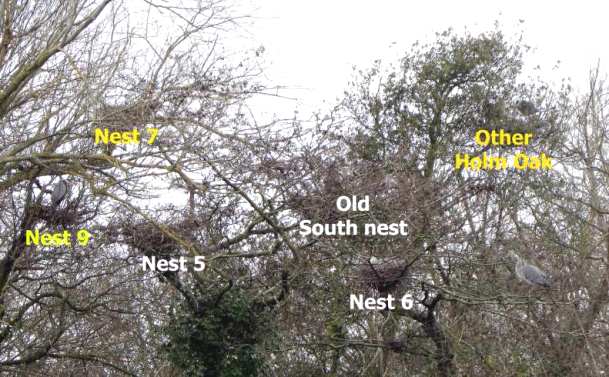
Peter also sent photos
of the recently fledged youngsters from the Old South
Nest trying off new skills of balance and stabbing at
sticks.
Also on the pond, were
the two Mute Swans coming to bread-giving kids. I
noted that 6 eggs were in the nest before the pen sat
back down again.
Horse Paddock: 10 Teal and 10 Moorhen. With 2 singing
Chiffchaff.
Off shore were 61 Black-tailed Godwits, 28 Med Gulls,
Just 2 Brent Geese, and 2 Great crested
Grebes.
SUNDAY
APRIL 3 - 2016
Brook
Meadow workday
I attended the
first Sunday in the month work session on the meadow
as usual to take photos of the volunteers at work for
the web site. Here are the volunteers assembled at the
tool store before the session with wheel barrows at
the ready!

There were two main
jobs. One to cover the rubble ramp that Maurice Lillie
and volunteers made yesterday with path gravel. This
ramp is mainly to provide easy access for the new
power scythe, though it can also be used as an
alternative route for pedestrians. The other main job
required moving several barrow loads of path gravel
all the way from the Seagull Lane gate to the south
meadow to fill in a large puddle on the main path near
the south gate.
A full report on the
work session plus more photos can be found on the
Brook Meadow web site . . .
http://www.brook-meadow.hampshire.org.uk/bm-diary-current.html
Wildlife
observations
Chiffchaffs
were singing from Palmer's Road Copse and Lumley gate,
but still no Blackcap.
The brown spikes of Lesser Pond Sedge are
showing well on the river bank north of the sluice
gate. What looks like a young Jew's Ear fungus
is growing on a dead branch at the bottom of the steps
leading down to the south meadow from the seat.
Slipper
Millpond
I had a quick
look at Slipper Millpond where I found a pair of Coots
nesting in the box on the north raft, but no sign
today of the Great Black-backed Gulls.
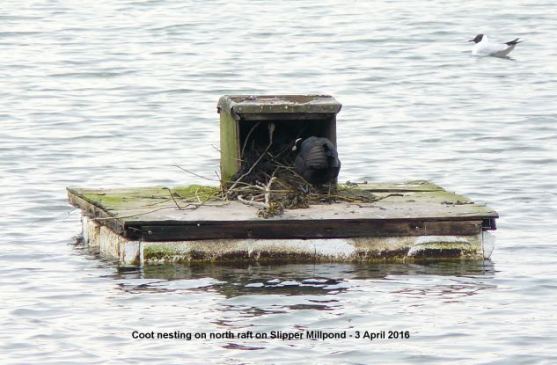
More
Crests
Peter
Milinets-Raby had a walk with his family this
lunchtime along the Billy Trail from Noon to 1:30pm
during which he heard both Goldcrest and
Firecrest singing.
"Firecrest was seen in the Billy trail trees at the
rear of the gardens just two gardens down (south) from
the Glenhurst nursery wooden building (which puts it
within a few gardens of Ralph Hollins' garden). The
Firecrest responded very well to a MP3 playback giving
great views. It chased a second crest which I did not
quite get onto - so maybe a second or just a
Goldcrest.
Later in the afternoon after we had coffee &
panini at the Rowlands Castle cafe (roughly 3pm)
another singing Firecrest was seen above the flint
wall in amongst a small clump of yew and deciduous
trees (opposite the 'green' and Lloyds Bank). Again,
it responded well to a MP3 playback, raising its flame
orange crest to an extent that it reminded me of the
punk pigeon from your blog! Superb views. Also of note
were 3 Med Gulls passing over calling as they headed
further inland."
Bob
Chapman correction
Ralph Hollins
informs me that Bob Chapman is not back at Farlington
Marshes as I incorrectly reported on Mar 26. Bob's
current job title is Reserves and Projects Manager
(New Forest & Avon Valley). Ralph thinks the
Solent Reserves (including Farlington Marshes) are
managed as a group by Rob Skinner who apparently
produces the entries on the blog at . . .
https://solentreserves.wordpress.com/
SATURDAY
APRIL 2 - 2016
Emsworth
to Langstone
Peter
Milinets-Raby was out early this morning starting at
Emsworth Harbour at 6:39am (two minutes after sunrise
and half an hour before a 3.7 metre high tide). He
says, "Not much around: 2 Coot, 1 Great Black-backed
Gull, 1 Great Crested Grebe, 4 Teal, 1 Shelduck, 3
Canada Geese and heard from Thorney Island (south wind
blowing) was a singing Cetti's Warbler! Chiffchaff
seen in the garden by the yacht club.
Straight to Warblington at 7:18am: Ibis Field: 3
Curlew and a male Pheasant, 1 Stock Dove, a singing
Chiffchaff and with 2 Mediterranean Gulls over.
Hedgerow behind Conigar Point: 2 Long-tailed Tits,
singing Chiffchaff heard and surprise, surprise 3
Greylag Geese flew low over the field and
headed east.
Conigar Point: 6 Med Gulls flying over and 14 resting
on the last bits of sea marsh along with 2 Grey
Plover, 5 Brent Geese and 14 Shelduck. On the water
were 3 Pintail (a male with 2 females) and 2
Red-breasted Merganser. Cetti's Warbler singing from
the mini reed bed with a Chiffchaff singing in the
Tamarisk hedge.
The best sighting of the morning was of a Common
Seal that tried to climb out of the water onto the
"island" in the middle of the channel. Very dark grey
animal, which lolled about out of the water for 10
seconds or so before slipping back into the water.
Off Pook Lane: 27 Brent Geese with a single Great
crested Grebe and 2 Red breasted Merganser. 2 Teal, 2
Great Black-backed Gulls, 1 Swallow flew north
(my second of the year, so it is now officially
summer!!!), 4 Mediterranean Gull, 1 Greenshank (B//R +
GR//-) and 18 Black-tailed Godwits. 1 male Linnet,
Little Owl perched in it's usual tree.
In the field south of Warblington Church was a
Black-headed Gull with a white ring on it's right leg
with the characters "2L59".
Flooded Horse paddock: Numbers dwindling with just 7
Teal, 9 Moorhen, a singing Chiffchaff and a Green
Woodpecker heard laughing.
Langstone Mill Pond: Chiffchaff singing, 2 Little
Egrets calling to one another and roosting together.
First hint??
Grey Heron colony: 9th nest: still under construction.
Adult pair in courtship display and mating. 7th Nest:
the huge nest at the rear: Two calling chicks seen -
maybe a third??? Old South Nest: 3 young on the verge
of fledging. Other Holm Oak: 3 young, again on the
verge of fledging - adult swamped when it came in to
feed these three vivacious youngsters.
Firecrests
galore
Following the
observations of Caroline French and Martin Hampton
about the good number of Firecrests in the local area
(see this blog for Mar 23 and Mar 24), Ralph Hollins
reported in his wildlife diary that the Dungeness Bird
Observatory recorded a massive influx of 120
Firecrests on Mar 30. This confirms many birders
comments that there are a lot more of these tiny birds
than usual all along the south coast currently.
FRIDAY
APRIL 1 - 2016
Stansted
walk
Jean and I had
a short walk through the east side of the Stansted
Estate this morning from the cafe to the Iron Gate
Cottages and then along the track to the 5-ways
footpath junction at the far end.
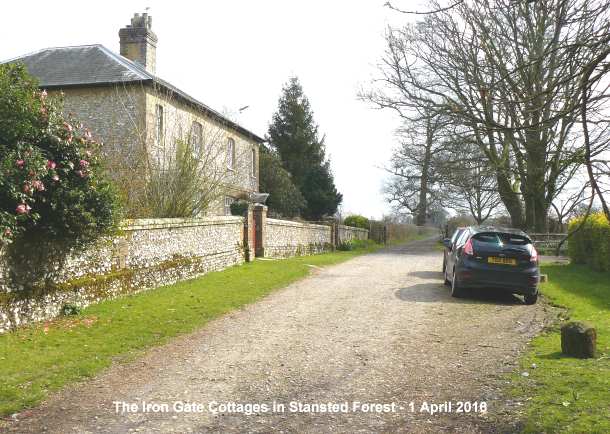
It was a bit muddy in
front of the house, but otherwise it was fine. There
was plenty of bird song, but nothing special.
Chiffchaff was the only migrant heard. I listened out
for Mistle Thrush but heard only Song Thrush.
However, we did see a few spring flowers, including
Ground-ivy, Scentless Mayweed and Dog's Mercury. I
also had my first Oak leaves of the year. All shown in
the following photos.
Tony's gallery
Tony Wootton
got some cracking photos from his visits to Blashford
Lakes and Ibsley Common yesterday. They included a
female Brambling, a Reed Bunting, a Dartford Warbler
and a small group of Fallow does.
For
earlier observations go to . . March
17-31